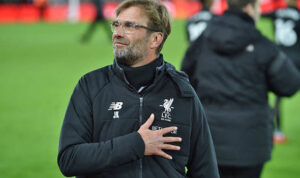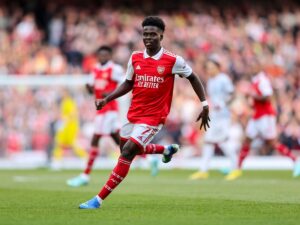The Future of Arsenal: Gabriel Martinelli
“Everyone should remember the name” is what Jurgen Klopp had to say about Gabriel Martinelli.
He wasn’t asked about the player, but that doesn’t matter. The Liverpool manager was expressing his admiration. Over the course of this analysis, I hope to shed some light on one or two of the reasons why.
This is another part of the Future of Arsenal series. See articles on Emile Smith Rowe and Martin Ødegaard for more of that.
For Martinelli, there is plenty to focus on regarding typical technical ‘forward play’ – close control, dribbling, shot power and accuracy, body shape, composure and passing – and I will try to demonstrate visually how his ability on the ball points toward a fantastic prospect. But more than that I want to highlight how Martinelli’s intent, his movement, the way he approaches his game, could lend itself well to Arteta’s Arsenal moving forward. Especially as they look to answer that age-old riddle in football: how to score more goals.
Position and movement
In terms of his raw profile – at least the one he has currently, at 20 years old, with a lot of room for change and improvement – Gabriel Martinelli sits somewhere between the typical wing forward and a centre forward.
For Arsenal, Martinelli is mostly a left sided wing forward. He is able to find open spaces beyond the opposition midfield line and wide of their full backs. From here he can move either outside onto a passable left foot or inside onto his favoured right.
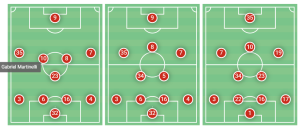
He generally puts himself closer to the final line, looking to run beyond it, rather than dropping in to receive the ball earlier – as Bukayo Saka might on the Arsenal right flank. Martinelli seems to carry greater instincts for direct and aggressive centre forward play than he would as an attacking midfielder or supporting winger.
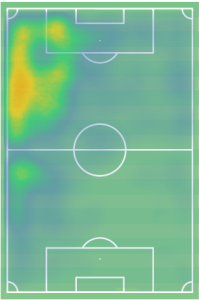
If he isn’t out wide, Martinelli can sometimes be found operating as a lone centre forward ahead of a defined number 10 – usually Martin Ødegaard. Arsenal’s system caters toward an advanced centre forward who adopts a more supporting role.
Lacazette is generally the choice here, but Martinelli does possess the energy, timing and general strength of determination to justify that place as a more ‘defensive’ centre forward.
Martinelli is happy to engage and participate in an active pressing unit – something he is actually quite adept at – and this approach has been a tactical priority under Mikel Arteta.
However, if Gabriel Martinelli is going to be the player to run clear of the defensive lines, to offer a consistent option as the final pass receiver, to be the ‘finisher’, then he will likely remain the left wing forward, and at this time this is probably his strongest position.
To highlight a notable separation in the kind of movements Martinelli favours in-game, I have compiled a few examples from two recent fixtures. The first was Arsenal’s 2-1 defeat at the hands of Manchester City and the other their 5-0 win over Norwich City.
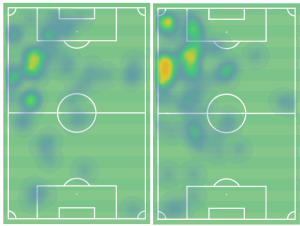
Against Manchester City, Martinelli began the game as the left wing forward in the 4-2-3-1 shape before switching to a more advanced centre forward after a tactical shift forced by Arsenal defender Gabriel being shown a red card.
In the earlier stages, Martinelli lingers wide of play, looking to exploit a narrow and compact Man City defensive line. He wants to run ahead of the ball and receive the pass beyond his defender. With his team in possession, there is a lot of active and direct running into open spaces.
When his team play without the ball, Martinelli is alert and prepared to support the press with an option to overload should they win possession. Martinelli’s movement takes him through wide channels as well as between centre backs through the middle depending on where the ball carrier is.
A lot of the running is there to provide an open option to receive the ball. It is the mark of an aggressive attacker, one who wants to offer options that can feasibly lead to a chance at scoring.
Towards the end of the game, with Arsenal in a much tighter, much more defensive shape having received the red card, Martinelli acts as a more typical number 9 outlet. He is still an active runner, he is still offering the option, but without the players to support the movement and occupy markers, he is defended far more easily.
Against Norwich a few days earlier, Gabriel Martinelli enjoyed 33% more touches as he faced up against a far more rigid and numerous defensive unit.
In this game, Martinelli still wants to attack the spaces before receiving the ball. He wants to receive his pass in space but, with Norwich playing deep and packing their defensive third with players, Martinelli often found himself receiving the ball early and dribbling at the defensive line. In these cases, he would usually release the ball and then make his run.
He is comfortable attacking spaces without the ball and providing that option – hopefully a high-quality one – as the final receiver. Playing the short pass and running clear beyond his marker is the option Martinelli takes before attempting a direct dribble.
His willingness to repeatedly identify and use high intensity sprints in order to hit those spaces was readily apparent in this game.
Against the positional control and possession based super strength of Manchester City, the forward’s role – Martinelli included – is about defensive positioning, anticipation, aggression and opportunism as much as it is about inventiveness, creativity or technique.
After all, when you face Pep Guardiola’s side your whole team must defend as a single aggressive, organised unit or it risks being picked apart. This match gave a good account of Martinelli’s positional habits in a game where he has those spaces ahead of him, where being clever off the ball is as necessary as being effective on it.
When he faced Norwich however, it was very different. What little space there was beyond the defensive line had to be exploited quickly because there were always numbers to cover. The defensive line dropped deep, defensive markers were rarely isolated by their attackers.
Here Martinelli’s positional game was better defined by his decisions on the ball. To receive it he would often drop into a hole between midfield and defensive lines or wide of his markers. He wasn’t able to find open spaces ahead of his position – the Norwich approach wouldn’t allow it. To combat this Martinelli would first move the ball on and then make his own movement; he would look to initiate 1-2 short passing moves, he would try to force the space by introducing speed, aggression and ingenuity. It is much more proactive.
It is the kind of aggression and directness in the approach that is needed to combat the numbers utilised in an organised Premier League mid-low block.
The movement habits of Gabriel Martinelli point towards a player with the instincts of a goalscorer, one who wants to cause real and meaningful problems for his defensive counterparts. But these aren’t blindly optimistic movements. He is considering what can be done by him, off the ball, to give himself the best chance to score when he next receives it. He wants to give himself the best chance at scoring by giving his teammates the best chance at picking him out.
Martinelli is effectively trying to simplify the process. High-risk dribbling or line breaking passes are opted against in favour of simple horizontal passes followed by high quality attacking runs. Martinelli is creating by offering himself as a sensible high-quality option to receive the ball a couple of phases later.
Having looked at the way Martinelli locates, attacks and occupies forward spaces, let’s see how this translates.
Finishing and the scoring of goals
Across those appearances for the Arsenal senior team – four competitions, a little under 4000 minutes – Martinelli has scored 16 times.
Among those was a pair against Liverpool in the league cup, which led to manager Jurgen Klopp labelling Martinelli “talent of the century”, which was shortly followed by a six-month lay-off to what was initially thought to be a minor injury.
Martinelli’s shot accuracy over this period stands at 40% (after 89 shots – remarkably low, only 2 shots per 90-minute appearance). His expected goals total is 13.9.
You will immediately notice the leading role played by those open spaces. Martinelli offers the option in space – as we’ve seen – and if the pass or cross is executed, a good chance can be created.
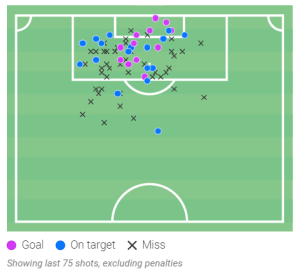
Whether it’s a considered and deft curling shot with the instep of his right boot, a near post header, a far post tap-in, or a delicate dink over an onrushing goalkeeper, Gabriel Martinelli is often in full control of his shot.
He rarely shoots from long range. In fact, he rarely shoots with defenders ahead of him at all. Martinelli favours a 1 v 1 and he favours giving himself the best possible chance to score.
The general nature of his goals fit within the profile of a natural, confident and adept goal scorer. His use of spaces caters perfectly to that as does his favouring of high percentage shot actions.
Martinelli is taking up positions to receive the ball in 1 v 1 situations or for a shot rebound; he is nominating himself as the last receiver for a through ball or cross. There is plenty of intelligent decision making, especially with regard to knowing exactly what is needed to score the goal – a skill few players possess naturally, especially from a young age.
This is a player to whom scoring goals, and the many nuances that it involves, comes as a natural talent. He is versatile in his technical capacities, he has no problem adapting his positional play to heading the ball and he can maintain his accuracy through this. The decisions he makes – both before and after receiving the ball – and the manner in which he makes them point toward an intelligent and thoughtful finisher.
Gabriel Martinelli isn’t totally absorbed by his hunger for goals the way that other, more defined centre forwards might be, but he has the capability to be that player and there is a chance that one day, under the right manager, he may become that player. He does carry the tools for it.
Because of the kind of situations his movement and style often finds him in, a lot of the general focus for Martinelli naturally veers towards his ability to hit the net. And there is certainly enough to talk about there. But that isn’t the only strong and notable string to his bow. Martinelli has plenty of further qualities.
Dribbling, passing and the creation of chances
Across that sample of minutes for Arsenal. Gabriel Martinelli averages 5.2 take-on attempts per 90. 54% of these are successful. High numbers on both counts. If we include all of his appearances in all competitions over the four years of his senior professional career – increasing the sample to just over 7000 minutes – this stands at 5.8 dribbles per 90, 54% successful.
While we’ve explored Martinelli’s habit of attacking spaces off the ball, it is wrong to say that this preference is due to any weakness or inability to attack those spaces with the ball at his feet. When the situation calls for it, as it often does, there is a clear willingness in Martinelli to attack his defender head-on.
It’s a no-frills, effective method of dribbling. While I’m sure Martinelli is capable of silky step-overs and Maradona-esque pirouettes, it isn’t something he does very often. When Martinelli beats his man, it’s usually functional. He blends tight close control with strong athleticism.
He is a powerful runner. A strong sprinter. Martinelli is able to cover the open spaces quickly, often quicker than his covering full back – which is, in the end, what counts. He carries the same aggression in his directness as he does with his off-the-ball movement, but he marries it with really strong agility, pace and ball control.
The bottom line for Gabriel Martinelli is the occupation of areas where goals can be scored. Whether he does that ahead of play, taking up positions off the ball as we saw already, or whether he does that with the ball at his feet, using well-timed touches and bursts of acceleration, the destination and the intention is the same. He wants to put himself in a position where he will be a threat to the opposition goal.
It’s not always a shot that manifests as this threat. Martinelli is a useful creative supplier too.
As we’ve already explored, since moving to Arsenal, Martinelli has been a wide player for most of his appearances. He is still a forward, he is still making the movements and playing the kind of game we would call typical of a forward, but he is a wide one. He occupies wide areas, especially when receiving the ball in earlier phases – as we saw in the game against Norwich.

Martinelli certainly isn’t a high volume creator. He is averaging just 2 passes into the opposition penalty area and 0.8 passes into the opposition defensive third per 90. He is only receiving 14 passes per game. As we’ve seen, he is far more likely to be found running ahead of play, occupying spaces, playing on the edge of offside than he is to be dropping in and contributing to the earlier, more creative and supportive phases.
And yet, his balls into the penalty area are 44% accurate. Not sky-high, but strong. Especially when you consider Arsenal do not currently have a player who will dominate the penalty area. The closest they have to a defined number 9 is Alexandre Lacazette and, as we’ve seen, he isn’t that player. Neither is Saka or Smith Rowe. You are more likely to find Martinelli himself taking up that role.
His passes into the final third, while they are very few – and why wouldn’t they be – are 64% accurate. The passing isn’t his standard approach, it simply isn’t how Martinelli plays his game, but when he does play that game, he plays it well.
He has an accurate and confident cross. He doesn’t hesitate to attempt to pick out his target if that target is present and open to receiving the ball. If Arsenal do eventually bring in a more defined centre forward, one who might try to dominate the penalty area, then we might see Martinelli’s creative output increase. The capability is there, the active practice currently isn’t.
Pressures and defending from the front
Something that is more of a side note for the player Martinelli is, but something worth covering still because there is plenty to be impressed by, is his defensive work. He is among Arsenal’s most active pressing forwards, and a lot of this comes from a degree of determination and tenacity that apparently comes naturally to the player.
If I’m guessing, it is likely this attitude towards his defensive work – which generally ties into the amount of running Martinelli does off the ball generally – that appealed to the interests of Jurgen Klopp ahead of any technical or physical attribute.
He is an extremely active forward out of possession. He wants to win the ball, he wants it back, he wants to pressurise and hassle the opposition if they have possession, he is generally a bit of a nuisance. And that is a priceless attribute for a forward.
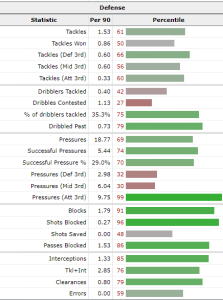
His timing is absolutely fine, he isn’t usually rash with his decisions. He averages just over 1 foul per 90 for Arsenal, 0.1 yellow cards. His overall defensive duel win percentage stands at 63% – remarkably high.
Roberto Firmino, arguably one of the world’s best ‘defensive forwards’, wins 59% of his defensive duels in the Premier League. Martinelli not only contests nearly 2 defensive duels per 90 more than Firmino, but he also wins more of them.
Martinelli sits within the 99th percentile among comparable players for active pressures in the final third. For basic defensive metrics – interceptions, blocks and clearances – Martinelli is within the top 20% of players.
It’s important to note that defensive work, when undertaken by any player in any position, signals some amount of effort and intention to take up position and challenge their opponent.
For Martinelli to clear the ball, he has to contest for the ball within defensive areas. Likewise to intercept he has to anticipate and move into passing lanes. To block a shot he must be between his own goalkeeper and the opposition attacker.
He is getting around the pitch quickly enough to put himself in these situations. Again, the man makes a nuisance of himself.
Gabriel Martinelli
The thing I like most about Martinelli is how he simplifies the process of being a forward. If you can get the basics right, you will probably do well.
Martinelli ensures his preparation is good; starting position is key, he makes absolutely sure that when he receives the ball he does so in a position where he can take the next step with a good chance of success.
His physicality is effective; Martinelli is fast, agile, and he has the balance to carry the ball quickly while under control, he understands his physical capacity and uses it to advance his position. I used the word no-frills before, I think covers it nicely. It’s effective.
His technique is sound; Martinelli favours accurate strokes with the instep. He wants to hit the target and does so consistently. He rarely shoots from range, his preparatory positional work means he rarely needs to shoot from range.
Effectiveness is another keyword in his analysis and it’s one that usually accompanies the most successful players over longer periods of time. The consistent effectiveness of his actions will ultimately decide how much impact a player has.
Considering how well Martinelli has presented himself already, the way he shows us his style and allows us to pick his game apart through clear examples against top-quality opposition, and considering that 6 months of this 20-year-old’s short career was spent recovering from a serious and potentially debilitating injury, I confidently believe it is safe to say that Martinelli has real, tangible promise to play at the very top level. The actual elite level.
Gabriel Martinelli is excellent now, his game is mature and intelligent, and this will probably only continue as he develops the fine-tuning that comes only through experience. The player has a big future. Arsenal FC will want to do everything it can to ensure it is spent with them.
